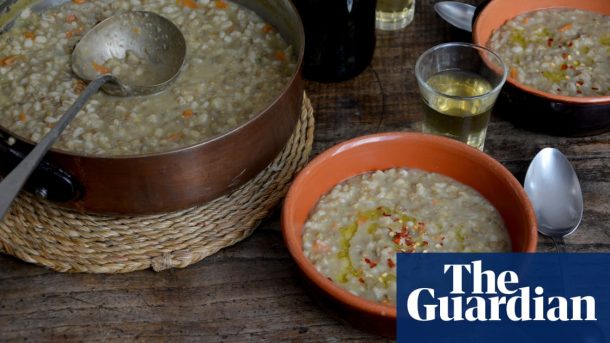A typically Roman, rustic soup-stew made with ancient pulses
Like many of their generation, my grandparents managed the chaos of life with tins. Biscuits, buttons, screws, tea, picture hooks, old keys, shoe polish, used stamps, crackers, cakes, shortbread, plasters, crayons: all had one. Even tins – liquorice, mints, balms – had a tin, some of which seemed as old as my grandparents themselves, and were hard to open. Others celebrated events, or were reminders of places visited. The best tins by far, however, were those full of sweets. One lived in the kitchen, the other in the glove compartment of Grandpa’s immaculate car.
I can picture my grandma opening the kitchen sweet tin, which was blue with a raised white pattern and shaped like a postbox; she’d pull off the lid, then lower it to grandchild level. I remember the cold smell of Fox’s Glacier Mints (Grandma’s favourite, so always dominant) and how we would rummage past their blue-and-white wrappers in search of a humbug or barley sugar. The dimensions of a boiled sweet are perfect, as are a wrapper that can be twisted off and the thick sweetness of a barley sugar, the most wholesome of sweets.
I kept that thought until recently, when I discovered that barley sugar sweets don’t contain any barley. They did when they were first made in the 1600s by a French mother superior, who mixed barley water with sugar when looking for a remedy (apparently). I wonder when the recipe changed. Florence White’s, in her 1932 book Good Things In England, uses lemon and almond oil. I am similarly deluded with the Italian drink orzata – orzo being the Italian for barley – which was made into a cloudy syrup that refreshed generations of over-heating bambini, but is now made with almonds. So, in light of the concerning news that I can no longer rely on getting my daily barley from sweets and syrup, I have been looking at alternatives.
Barley, along with lentils, peas, bitter vetch, chickpeas, emmer wheat and einkorn, is one of the eight Neolithic founder crops domesticated in the Fertile Crescent more than 12,000 years ago. Like all grains, its consumption is often observed at four stages: raw; toasted, and soaked or boiled; milled; and mixed with flour to make dough. The boiling is where I am today, with another ancient one, lentils: together, they produce a fantastically robust but gentle soup that we recently ate at a great place not far from Rome’s Porta Pia called Fiaschetteria Marini. You need beautiful pearl barley here.
It is wonderful the way barley transforms as it cooks, from hard pearls to plump buttons, their texture and flavour a combination of oats and wheat. And it has a milky almost-sweetness about it – no wonder it makes such wonderful sweets. Barley is enthusiastic, too, and continues to swell off the stove, so add extra water and salt for a swishing rather than a stiff consistency. And while, sadly, it won’t help world chaos, it might help keep the cupboard in order if you keep the leftover pearl barley in a tin.
Prep 10 min
Cook 40 min
Serves 4
1 onion, peeled and finely diced
1 stick celery, finely diced
1 carrot, peeled and finely diced
Salt and black pepper
5 tbsp olive oil
1 small potato, peeled and finely diced
2 bay leaves
250g pearl barley
250g small brown lentils
In a soup pan with a heavy base, gently fry the onion, carrot, celery and a pinch of salt in the olive oil until soft and translucent. Add the potato and bay leaves and cook for a few minutes more.
Now, if their cooking time is the same (about 30 minutes), add the lentils and barley , along with a litre and a half of water. If they have different cooking times, add one and the water, then add the other a bit later. Bring to a boil, then reduce the heat and simmer, stirring occasionally, for half an hour, or until both lentils and barley are tender. You will probably need to add another 500ml water – keep an eye on this.
Remove half the soup, blend until creamy, then return to the pan and add salt and black pepper to taste. Serve with a little olive oil on top, plus red chilli flakes or croutons, if you like.
UK readers: click to buy these ingredients from Ocado
Rachel Roddy’s recipe for pearl barley, lentil and vegetable soup – The Guardian





